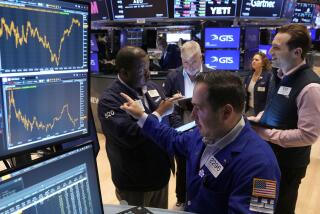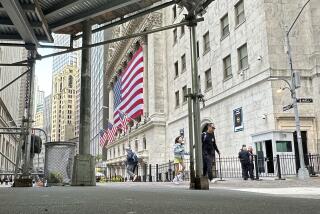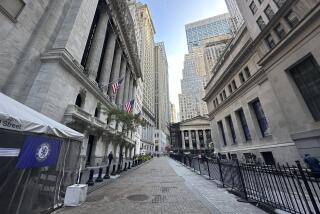Dow Climbs 30.19 in Final Hour’s Rush : Market Overview
Highlights of Thursday’s market activity, compiled from Times staff and wire reports:
* Blue chip stocks, after seesawing all day, soared in the last hour on computer-triggered buying, but the broader market was weaker.
The Dow Jones industrials climbed 30.19 points to 2,976.52.
* Treasury bond yields rose again as the Federal Reserve continued to signal that it isn’t prepared to ease credit further just yet.
Stocks
The Dow’s abrupt rally recouped less than half the 72.01 points the index lost between Oct. 1 and Wednesday’s close.
On the New York Stock Exchange, rising issues outnumbered losers about 10 to 9. Volume slowed to 164.24 million shares from Wednesday’s 186.71 million.
Investors were clearly focused on third-quarter earnings, and a better-than-expected report from Dow component J. P. Morgan & Co. drew buyers to other bank stocks as well, analysts said.
Morgan jumped 2 1/2 to 63 3/8 after it cited an economic rebound in Latin America in reporting a 75% jump in third-quarter profits.
But because so much of the buying stemmed from computerized short-term trading strategies, analysts warned that the market is still vulnerable to further losses if interest rates continue to rise.
“The direction has been dictated by programs (traders)” rather than fundamental investors, said Ron Doran, trader at C. L. King.
Among other highlights:
* Other bank stocks that rose sharply included Bank of New York, up 2 1/2 to 30 3/4; Wells Fargo, up 2 to 67 1/8, and Mellon, up 7/8 to 33 3/4.
* While the jump in bond yields might have been expected to hurt interest-rate sensitive stocks, some ignored the bond market. Federal National Mortgage rocketed 3 to 62 7/8 in the wake of its strong earnings report.
* W. R. Grace led industrial stocks higher, rising 1 3/4 to 36 after brokerage Bear Stearns upgraded the chemical stock to a buy.
* Oil stocks rallied as oil prices continued to hover at their highest levels since the Gulf War. Mobil rose 1 to 69 1/4, Arco added 1 1/2 to 118 3/8, Baker Hughes gained 3/4 to 24 1/4, and Sun rose 7/8 to 28 7/8.
* There was wild action in tech stocks once again. Intel surged 3 1/2 to 42 after the semiconductor company reported higher-than-expected third-quarter earnings. Other big gainers included Motorola, up 1 1/4 to 59; IBM, up 2 1/2 to 99 3/4, and Intergraph, up 2 to 18 1/2.
But software firm Aldus plunged 4 1/4 to 37 on disappointing earnings expectations. Another software firm, Xilinx, lost 3 1/4 to 23 3/4 despite reporting earnings up sharply.
* Retailers were mixed after Wednesday’s steep losses. September sales reports, issued Thursday, were uniformly weak. Limited slid 1 3/8 to 21 3/4, but Nordstrom rebounded 2 to 35 3/4 after tumbling 8 1/2 Wednesday. (Retail story D1.)
Overseas, London’s Financial Times 100-share average lost 13.3 points to end at 2,570.8. Frankfurt’s DAX average closed 0.73 points higher at 1,567.95.
The Tokyo exchange was closed for a national holiday.
Credit
The Treasury bond selloff continued, but the pace slowed.
The Treasury’s 30-year bond fell 19/32 point, or $5.94 per $1,000. Its yield rose to 7.96%, up from 7.91% Wednesday and 7.82% Tuesday.
For a second day in a row, the Federal Reserve drained reserves from the banking system in an attempt to shore up short-term interest rates. The move brought the closely watched federal funds rate, the interest banks charge each other for overnight loans, to 5.06%, up from 5.0% Wednesday.
The Fed confirmed Thursday that it was executing what are called overnight matched sales, in which the agency temporarily sells government securities to drain cash from the system.
The Fed’s action appeared to be a signal to the bond market not to expect easier credit soon, despite analysts’ belief that the central bank must lower rates further to help the weak economy.
Even so, if traders believed market interest rates were going much higher soon, the bond selloff would have been far worse Thursday, analysts said.
Currency
The dollar settled mostly higher in volatile trading sparked by rumors that Russian President Boris Yeltsin was missing.
The rumor “created a flight-to-quality buying of dollars,” said Robert Hatcher, a corporate dealer at Barclays Bank.
Reports of Yeltsin’s disappearance were denied, but not before the dollar had broken through key technical levels.
In New York, the dollar rose to 1.696 German marks from Wednesday’s 1.689, and to 130.35 Japanese yen from 129.80.
Commodities
Grain and soybean prices were mostly flat Thursday, but traders warned of wild action today: An Agriculture Department report issued after the market close put the U.S. soybean crop nearly 70 million bushels above even the most expansive estimates.
The bean crop was damaged by frost last month in parts of Iowa and Minnesota, but August rains provided late-season relief.
In Chicago, November soybean futures closed up 0.25 cent at $5.70 a bushel, but today could see a plunge.
Elsewhere, light, sweet crude oil for delivery in November settled at $22.98 per barrel, down 18 cents on New York’s Merc.
Gold for delivery in December was 80 cents lower at $361.30 an ounce on New York’s Comex; December silver was 3.6 cents lower at $4.08.
More to Read
Inside the business of entertainment
The Wide Shot brings you news, analysis and insights on everything from streaming wars to production — and what it all means for the future.
You may occasionally receive promotional content from the Los Angeles Times.










